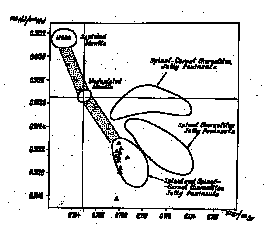
Rb-Sr and Sm-Nd isotopic systematics of a flow of K-rich olivine trachybasalt from the Manning Massif, Prince Charles Mountains, East Antarctica have been investigated for the first time. The volcanic rocks rest unconformably upon Precambrian granulites. The flow consists of several separate sheets each 2.5-7 m thick, occurring as individual small outcrops in an area about 5x2 km. Each sheet is composed of five components: (i) a chilled glassy base with vitroporphyritic texture; (ii) fine-plated vesicular basalt; (iii) massive fine-grained basalt with porphyritic microlitic texture; (iv) amigdaloidal aphanitic basalt with poikilophytic texture; (v) vesicular mandelstone of slag crust with vitroporphyritic texture. Isotopic investigations have been carried out on whole rocks of the least altered sequences i, ii and iii from several individual sheets forming a sequence from the bottom to the top. According to Nd-Sr isotopic characteristics (l43Nd/l44Nd=0.511771-0.512269; 87Sr/86Sr=0.707766-0.708351) trachybasalts were generated in a long-term enriched (Sm-Nd model age of the rocks has been estimated as 900-1000 Ma, and Rb-Sr model age has been estimated as 700-1000 Ma ) mantle source (Fig. l). The wide range of 143Nd/l44Nd values are more enriched for the bottom part of the flow and more depleted for the top part of the flow, suggesting progressive depletion with the generation of each new magma batch, which may be the result of chromatographic effects during percalation of uprising magmatic melts. Relatively steady and similar 87Sr/86Sr values for the samples from different individual sheets may indicate the resetting of Sr isotopic system during the late stages of the melts' evolution. Rb-Sr age determination on the bulk rock compositions from the sheet of massive fine-grained basalt (unit iii) representing high stratigraphic levels of the lava flow gives an isochron age of 40+1.2 Ma (ISr=0.70762) which is assessed as the age of the eruption and coincides within error with the previously obtained age estimations by R. Tingey (K-Ar method). This Cenozoic continental volcanic activity could be due to the separation of the Antarctic and Australian cratons. Nd-Sr isotopic characteristics of trachybasalts are very similar to those obtained for spinel Iherzolite and spinel-garnet Iherzolite xenoliths from the Mesozoic alkaline picrite of the adjacent Jetty Peninsula region. This fact may be indirect evidence that the mantle source of the trachybasalts were generated at the lowermost levels of spinel Iherzolite facies or at the highest levels of garnet Iherzolite facies of the long-term enriched upper mantle beneath the region.
Fig. l: Nd-Sr isotope plot comparing K-rich trachybasalts (triangles) of the Manning Massif with mantle xenoliths from the Jetty Peninsula, E. Antarctica.